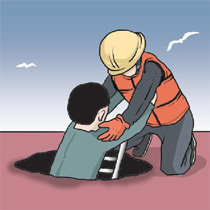‘You are not alone’
‘You are not alone’
Posted September. 12, 2019 07:33,
Updated September. 12, 2019 07:33

A miracle has happened. At 6 p.m. on Monday (local time), the official Twitter account of the U.S. Coast Guard uploaded a posting saying that “USCG and rescue crews have extracted the final #GoldenRay crew member safely.” Forty-one hours had passed since the Golden Ray, a carrying vessel for finished cars for Hyundai Glovis, had been overturned at the Brunswick port of Georgia state in the U.S. Of the 24 passengers, 20 had been immediately saved but the rescue was put to a stop when a fire broke out on the boat. The temperature of the vessel rose to over 50 degrees Celsius, combined by the fire and the sweltering summer heat. Back then, the lives of the remaining four Koreans could not be assured.
The Golden Ray, which is 199.9 meters long and 35.4 meters long, looked like a collapsed slope. Coast Guard rescuers boarded on the vessel and searched for survivors. It was in the daytime of Monday when they finally located where the survivors were, by knocking on the boat. The rescue was not hurried, but carefully planned out. The rescue team drilled a hole that was 7.6 centimeters wide and provided bread and water to the survivors and used endoscopy cameras to identify their location. They used a drill to make a hole to put a ladder through. Welding could have been faster, but they used a drill out of concerns that flames might spread. “We had spent the whole night in captivity, but the rescue squad used pipes and other tools to find ways to save us,” said Sailor A, who was the last person to be rescued, said in an interview with The Dong-A Ilbo.
The rescue of the Golden Ray reminded me of the “Miracle of the Hudson.” In January 2009, a U.S. Airway airplane landed in emergency due to an engine failure in just five minutes after taking off. All of the passengers were saved. The accident was made into a movie, titled “Sully: Miracle on the Hudson.” The movie portrayed the captain’s shrewd decision-making and dedicated rescue efforts, but a report on the investigation of the accident that was published later on concluded that life damage was prevented due to strong preparations. The report recorded the thoroughly consistent process of the rescue efforts, including how the emergency warning was communicated, how the rescue team was organized and when the ambulances arrived.
Lt. Lloyd Heflin, who led the rescue action, said that “When they made the knocking sound, it was a response to our message to stay aside the survivors. You need to let us know that you are not alone.” Thanks to their efforts, the survivors could stay hopeful and continue to knock on the boat telling themselves that they would be saved. Thanks to those who wasted no efforts in readily saving the lives of others, our society has a strong safety net. We are not alone.
Kyung-Im Woo woohaha@donga.com
Headline News
- Israel prepares for retaliation against Iran
- Samsung reclaims top spot, surpassing Apple in smartphone market
- 77% of Koreans in 20s and 30s are 'Kangaroo Tribe' due to job crisis
- KBO referees embroiled in controversy over ABS decision concealment
- Inflation, oil price surge put double shock on global economy







